#ttrpg blog
Text
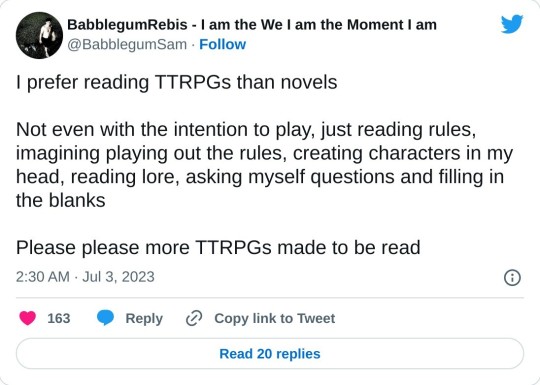
Been thinking about this & putting it into practice when writing The Perilous Pear & Plum Pies of Pudwick for a while: thanks to the ever excellent @babblegumsam (who you are probably already following and if not now is your chance to rectify that) for the final straw that made me write this up today. I truly believe if you have any interest in TTRPGs, play, or design you'll get something out of it, it's a further 5.4 mins read from here on out.
--------------------
Play is interaction.
Reading is interaction.
Below I will argue the necessity & usefulness of thinking the relationship between reading & play in TTRPGs as (almost) the exact same thing to unlock a wide & deep potential as reader/player/designer.
--------------------
Reading & play don't have to be the same thing. But you can't play without reading (in the sense of reading representations, images, ideas, concepts, interactions, etc, not just written text), because then there could be no interaction.
Reading and play can both accurately describe a given act or process. For instance: I read a table or piece of prose in a TTRPG book.
I say this because this is an idea that people struggle with, and while I encourage debate around the concept, we first have to agree on some basic building blocks that I hope I'm able to communicate here. For instance, there exists a potential reality in which tabletop roleplaying games are called tabletop reading games and nothing else about them changes (except for the consequential ability to think of reading in ttrpgs as play, and the potential this tool unlocks), because the prerequisite role for all other roles being played in a role-playing game is that of the reader.
This is true for much more than TTRPGs, but if we simply focus on acknowledging that reading & play in ttrpgs can and often are the same thing, then we are able to make informed design choices on this basis that we otherwise lack the agency to make – and which are nonetheless choices that are being made while we miss the opportunity to observe, read & ultimately interact and/or change and/or play with them.
To not think of the relationship between reading & play in TTRPGs in this way is to limit your agency as a designer, reader, player, and ultimately to cause yourself to be unable to synthesise these roles which are deeply inter-related, perhaps more so than they are disparate.
However you define it, Good Design necessitates the application of the right tool for the job. This requires making, maintaining & improving the tools that you have access to. The reader/player relationship is not only one of these, but an integral one that precedes a great many (if not all) of the other tools that you can & do employ as designer/player/reader.
If you allow this tool to remain blunt and imprecise (and especially if you don't acknowledge that it exists and that you use it in every choice you make), what you are doing is making a choice to blunt all of your other tools, even if you aren't aware of it.
This is poor design, poor play, and poor reading,* and I believe that this is true regardless of how you define each of those terms.
*though of course we could - and I think should - argue over the semantics & limitations of my imprecise use of the word "poor" there and the further ideas it smuggles in unacknowledged, but I trust that you will be able to infer what I'm trying to communicate in my use of it and I further hope that by leaving this imprecise application of a tool here in the way that I have used it, it might serve as a good example of the consequences, limitations & potential dangers of applying tools/terms/ideas that might be best described as "too blunt for the job", which is the very thing I'm attempting to highlight & address here.
It would not seem very sensible to choose to limit yourself in this way unless it allowed you access to new tools, which is a choice that you could only make once you are familiar with the central idea I'm presenting here – in other words, if you break the rules without understanding them you are very unlikely to be taking a step forward and much more likely to just be shuffling in place or even stepping backwards.
I hope that this short interaction has unlocked or reinforced your access to a useful tool that will allow you to sharpen your understanding of the play/reading relationship in TTRPGs and in turn refine & maintain your existing tools and your ability to synthesise new ones.
I look forward to discovering with you what new agencies this allows us to unlock, and I hope you take what you have read here and play with it to design new realities that you & I have yet to imagine.
#reading#play#ttrpg#indie ttrpg#ttrpg design#indie ttrpg design#tabletop roleplaying#games#game design#design theory#theory#design blog#ttrpg blog#ttrpg ideas#ttrpg resources#ttrpg mechanics#ttrpg dev#indie ttrpg dev#rpg design#ttrpgs for everyone#dialectics#communication design#communication theory#design philosophy#ttrpg community#ttrpg family#《 not a fan of that as a tool btw it is incredibly limiting and we could all do without it. why not be more precise & why not start now#any other useful tags you can think to add please do so. i think this deserves to reach far and wide & is very useful if i do say so myself!#Finally: take it and run with it. play/change/sharpen/blunt this tool. it's yours. make it your own (or dont). dont do what i say (or do) 🤡#respect & solidarity and thanks for reading. I hope you have found value in my contribution 🤝
263 notes
·
View notes
Text
Other TTRPGs I Recommend
While DnD is a fantastic system, I feel like it’s attention within the media and it’s popularity overshadows a bunch of other fantastic TTRPGs that are just as great (if not better) as any of the DnD editions! In light of this I want to spotlight a few others that I personally have played, or have kept my eye on to play as recommendations!
1) Monster of the Week
This one definitely may be one of the more well known smaller TTRPGs thanks to The Adventure Zone, however it’s my favorite so it’s absolutely my number one recommendation.
Monster of the week is specifically designed for short campaign arks and perfect for groups who may have sporadic schedules! This ttrpg is extremely reminiscent of the TV series Supernatural, and can accommodate a wide variety of campaign settings. Each session is centered around a situation designed by the Keeper and players must work through puzzles, problems, and combat to stop whatever creature, event, or mystery is ailing the area.
This TTRPG is perfect for people who prefer a less combat centered playstyle and want a system that allows flexibility in scheduling. It can easily be played as a one shot mystery or an entire campaign of fun investigating.
2) Bunnies and Burrows
Have you ever wanted to be a small woodland creature, living your life in the forest day to day surviving? Then Bunnies and Burrows may be for you!
This TTRPG is a roleplay heavy game that focuses more on problem solving rather than combat. You play as a small woodland creature living and enjoying your day to day in the forest avoiding perilous humans, environmental dangers, predators, all while trying to survive by staying fed and hydrated.
The leveling system in this game is very reminiscent of old school video games where the more you use a particular skill, the more you have a chance at leveling it up. It’s a fairly easy game to grasp and fun for those who want to experience a cute survival like TTRPG.
3) This Discord has Ghosts in it
This is probably the most unique “TTRPG” on this list. Rather than playing on a traditional tabletop setting, this system takes thing into a discord server to solve the mystery of a haunted house (discord server) as Investigators uncover the tales of the ghosts that call it home.
This is a fantastic system for long distance friend groups and allows everyone to interact as a player either as a ghost or an investigator. This system isn’t very campaign friendly and is meant to be played in one sit down session, but it has a lot of replay-ability and makes for a night filled with both fun and scary moments. The rules are easy to follow and the guide book even walks you through how to set up the discord server.
This is a fantastic system for large friend groups that may not be able to get together in person, and only has a limited amount of time to play.
4) Night Witches
This is a FANTASTIC ttrpg for any history buff. Play as a woman in the 588th Bomber Regiment in World War two as you stand against fascism while also dealing with sexism at the hands of your own servicemen.
This system deals with a lot of heavy topics, but is an absolutely beautiful tribute to some of the most inspiring and toughest women in military history. This game is designed for both single sessions and fleshed out campaigns and is a good system for those who wish to experience both the role of a game master and a player.
This is a Powered by the Apocalypse adapted setting and has all of the characteristics of a highly emotionally evocative game that has real anchors in actual historical events. This is a system that I have yet to play myself, but one I am extremely interested in and one that I do recommend solely on what I have heard from it.
5) Ten Candles
If you are a fan of horror rpgs with real world mechanics then this is the system for you! This system requires no pre game preparation and specifically designed for short one shots with a small group.
Playing by the light of ten real candles, discover what happens to your characters as you try to survive within the dark. This system is unique, as it leans heavily into a story telling horror rather than a survival system. At the end, after the last candle has burned away, every character will die to whatever fate awaits them. Every session is meant to be as unique as each scenario you play out as you discover what exactly happens to your group of characters in the dark.
If you like storytelling rpgs and like the idea of actually burning this as a game mechanic, then this system should be at the top of your list to play.
13 notes
·
View notes
Text
New Blog post is up about playtesting, some tips and a few playtest opportunities currently available namely Cairn 2e and the current game I am in a playtesting group. Feel free to post your playtest stuff here if you are looking for help with a game!
0 notes
Text


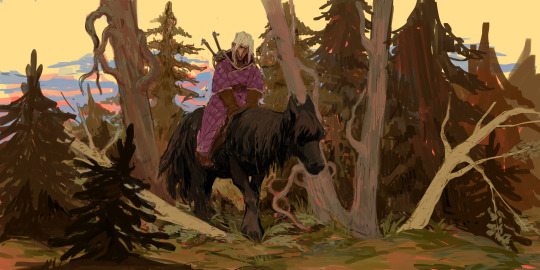
couldn't sleep so I made some iterations of my last work.
#artwork#concept art#ttrpg art#character concept#ttrpg character#the witcher 3#the witcher#sketches#ttrpg#the witcher oc#oc art#fanart#witcher oc#color study#art process#small artist#small art blog#fantasy art#art#artists on tumblr#my art#digital art#illustration#original illustration#art print#prints#shop
2K notes
·
View notes
Text
Chapters 4 and 5 are out now!!
0 notes
Text
Countdown Campaign. 6. Mechanics
So, while thinking about our dnd campaign, there’s a few things to think about that are thematic, flavourful and narration. Then there is elements that are mechanics, they are game rules we can change, tweak and alter, to reinforce the fiction into the game.
Now, 5e is great because there are TONS of these. It’s easy to add homebrew rules in- though it’s always best for new beginners to learn to walk before running, I’ve got some experience. The main things we can think about alterring are:
-Level Range- Where does the campaign start and stop? This decides how squishy, tough or complicated our PCs get. I like level 1 and 2 for being mortal, and I consider levels 4-10 a sweetspot for campaigns, so we’ll aim to end around level 7-9.
Now, as to which, there’s a pattern to all classes in 5e. Level 7 is fourth level spells, Level 8 is an ASI/Feat, Level 9 is fifth level spells- do we want to block off stuff like Greater Restoration, Raise Dead and Teleportation Circle? No, they’re not bad spells, and they feel EPIC for the highest level players will reach.
-Rest Mechanics- D&D’s difficulty relies on resource management. These resources- Health, Spells and Abilities, refresh on a rest, and in a typical game, after a night camped out. It is possible for a “Gritty” game to make it take a week to heal up, encouraging downtime. We’re not a downtime type game. We’re a ticking clock.
Therefore I feel like faster Short Rests work for us- a twenty minute breather means no spells will really carry over, but I think Long Rests should need comfort. Inns, taverns, safehouses, etc. That means that a journey across the wilderness is effectively a dungeon- you’re not getting your big spells back until you complete the journey, or you turn back. And it gives an onus to check in with places to stay- that five gold to sleep indoors is well worth it now!
-Experience- In the default rules, overcoming obstacles gives xp, which contributes to levelling up. Normally I prefer milestone xp, wherein progress and major achievements grant such levels and the party stays together. However, since we want a slightly grittier, perhaps unequal experience, then I think classic Experience will do.
-Inventory- In the default rules, you can carry a certain weight, and there are weights provided for anything and everything. I love the concept of the party getting a wagon, pack animals, or such, but I don’t actually care to book keep THIS much. So we’ll keep a vague inventory concept, and if they get a cart, then plenty of extra space.
-Guns- So, we want guns and cowboys in our campaign. And shockingly, even in the default DMG (pg268), there are gun rules! Are they complex? No. Are they as complicated as any other non-magical weapon? Yeah. But do they capture that showdown at high noon vibe? Not really. But they seem to be a good starting point, and we can always make magical special guns later, or look into gunslinger classes if a player is really enthused on that concept.
-Classes- Speaking of, sometimes it can be cool to restrict the classes and subclasses available in a campaign- if you’re trying to go for a “no gods” setting, then clerics and paladins might seem a little weird. I don’t really mind, so no changes here.
-Races- Similar to above, do we want to limit the race selection for this world? Yeah. I do. I haven’t decided on a full short list yet, but once we know what people live in this world, that’ll be the selection.
-Feats- Little optional ability packs, I always love using them. And while we don’t want our PCs getting too tough for zombies to threaten, I think using Feats as possible quest rewards is a great way to compensate for a rather bleak campaign setting.
-Crits- Rolling a natural 20 is a definite hit, and double dice damage on an Attack Roll, but is not an automatic success in other rolls. Rolling a 1 is always a miss or a failure, but I will try to have players fail dynamically.
-Deaths Door/Injuries- In default 5th Edition, you can go down to 0 hp, get healed, and have no consequences. I dislike this... ease around the 0 hp state, and I’ve previously used a rule that essentially gives a chance of injuries or permanent issues each time you hit 0 hp, or are hit for massive damage.
That’s a good summary- there’s possibility for other homebrew rules, but these are significant, campaign defining facets, and now that we’ve reasoned them out, we can see a bit of a shape emerging. Risky but not unforgiving, versatile but not too complex.
-Level Range- 2-9
-Rest Mechanics- Quick Short Rest, Safe Long Rest
-Experience- Default
-Inventory- Loose
-Guns- DMG modified
-Classes- Unrestricted
-Races- Short List
-Feats- On, and rewards
-Crits- Default
-Deaths Door- Injury Risk
0 notes
Link
TTRPRG Tuesday (on a thrusday) week 16 plus mermay day 26!
0 notes
Text



misc ttrpg things + hats😁
#ttrpg art#dnd#posting bc i need alazais on my blog...shes my girl!!!!#and her halberd is there in silhouette but i wonder if i should change her signature weapon. but i shouldnt#she's a major historical figure in my setting🤍and very dead#art
704 notes
·
View notes
Text

Do you think dragons sometimes go to pick up their kobolds and then they do that looooooong cat thing?
#dragon#kobold#dnd#ttrpg#fantasy#dungeons and dragons#pathfinder#I'm sorry that all I have time for are these shitpost quality level of doodles but anyway-#posting it on the right blog this time lol lmao lmfao#my art#also the answer to my question is obviously yes
870 notes
·
View notes
Text
In this dispatch of Jackalope Mail, I'm talking about some fun and weird folklore elements and how you can use them in your TTRPGs! Including trees fueled by blood and the ultimate dark academia setting! Check it out!
#jackalope mail#blog post#blogging#indie ttrpg#tabletop rpgs#ttrpg community#tabletop games#folklore
99 notes
·
View notes
Text
I think I'm doomed to always be a little unhappy with non-D&D seasons of Dimension 20 because they tend to treat any system they're running like D&D.
I'm on episode 2 of Mentopolis (which I'm loving) but Brennan Lee Mulligan keeps treating the checks like D&D handles skill checks. If you miss, nothing happens, and if you hit the DC, you do what you're trying to do. He also keeps getting so close to how Kids on Bikes works by saying "The DC is 8, but if you get a 12, you'll get something extra." That's great GMing, except that's how all the checks work in Kids on Bikes. You're always succeeding and failing by degrees. For example, here's what the rulebook says about hitting the difficulty exactly.
The character succeeds, but just barely. Decidedly, nothing surprising happens — and the player and the GM should make this success as skin-of-the-teeth as possible.
By contrast, succeeding with a margin of 10+ means you succeed "smoothly and easily," and potentially get extra bonuses from this success. But what happens if you fail a roll? There are degrees to it. For example, missing the check by a margin of 1-4 leads to this result:
The character fails, but not too badly. There might be some very, very minor short-term consequences, but these won’t shift the story for more than a minute or two. The character has tried and almost succeeded.
Even if you only fail by a little, something should happen other than "you don't succeed." Sometimes that's the result that makes the most sense, but most of the time the narrative should at least shift enough that the character would have a reason not to try to do the exact same thing again. For example, you try to jump up on a box to get a better view. You fail by a margin of 2, the box breaks when you jump on it. It's not a huge complication, but the PC will have to try another method or move on.
That's also why adversity tokens (they charmingly call them Moxie in Mentopolis) are so interesting. You can spend a few to still fail a roll, but have results be less dire, or spend some to succeed by an even larger margin.
I get that Kids on Bikes is kind of similar to D&D, but it is a different game, and the differences make the experience of playing so much fun.
205 notes
·
View notes
Text
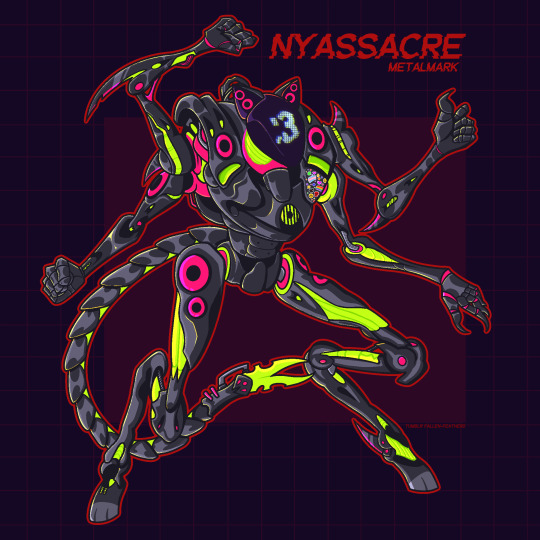
Friend told me about lancer, so I drew my first ever mecha :3
#lancer#lancer ttrpg#roleplay#mecha art#mecha#lancer rpg#ttrpg#ttrpg art#ttrpg community#rpg#my art#digital artwork#digital doodle#digital art#my artwork#art commisions#procreate#personal art#art blog#artwork#art#artists on tumblr#digital aritst#digital drawing#character art#metalmark#metalmark lancer#lancer mech
124 notes
·
View notes
Text
Congrats it’s an Intro Post!
Hi everyone! I figured I’d introduce myself and kind of explain my goal for this blog.
My name is River. I am an enbie living in the State of Michigan with a love for all things roleplay.
I got introduced to the world of TTRPGs when a dear friend in college ran a game of Pathfinder for our group of friends and I instantly fell in love. Since then, I’ve branched out to DnD 5e and then further with Monster of the Week, Kids on Bikes, and some of my own homebrew systems that have been loosely based on DnD5e. I want to eventually fully develop my completely own systems and am actually in the process of doing so now! I mostly DM for groups and enjoy building my own worlds than running premade settings, so you could say I’m more on the creative side of TTRPGs than I am on the game playing side.
Some dear friends have encouraged me to start a blogging journey and talk more about my knowledge and passion of the ttrpg community so I figured why not!
Give me a follow if you enjoy discussing and listening to a nerd info dump excitedly about various TTRPG systems, or even if you want to explore the world outside of DnD 5e!
#indie ttrpg#ttrpg homebrew#dnd#nerd#dnd blogging#ttrpg community#ttrpg blog#bg3#baldur's gate 3#rpg#dnd homebrew#tabletop#roleplay
11 notes
·
View notes
Text

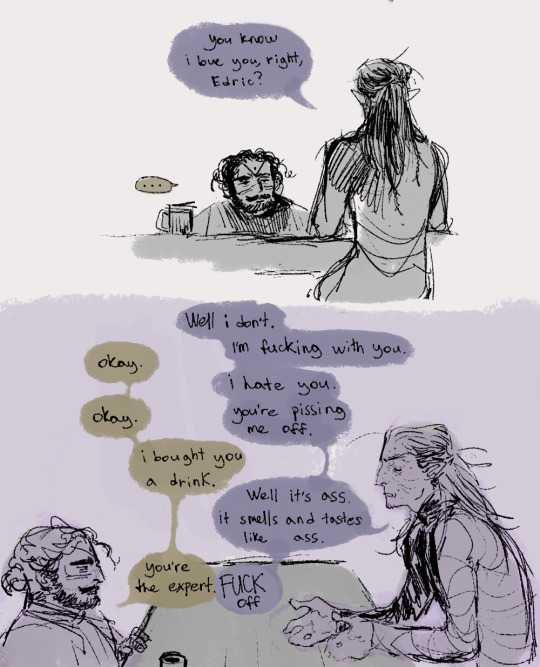
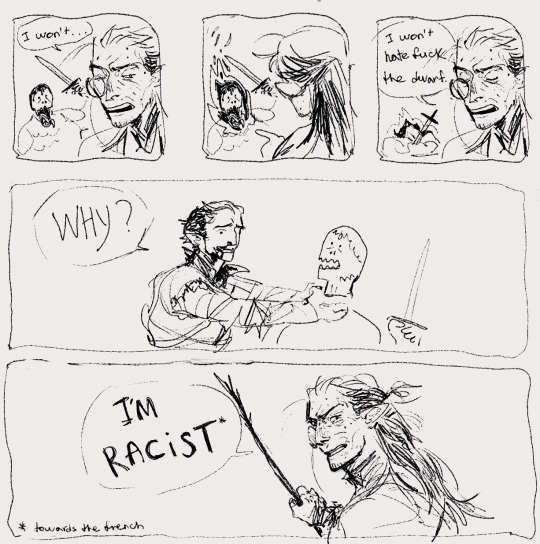
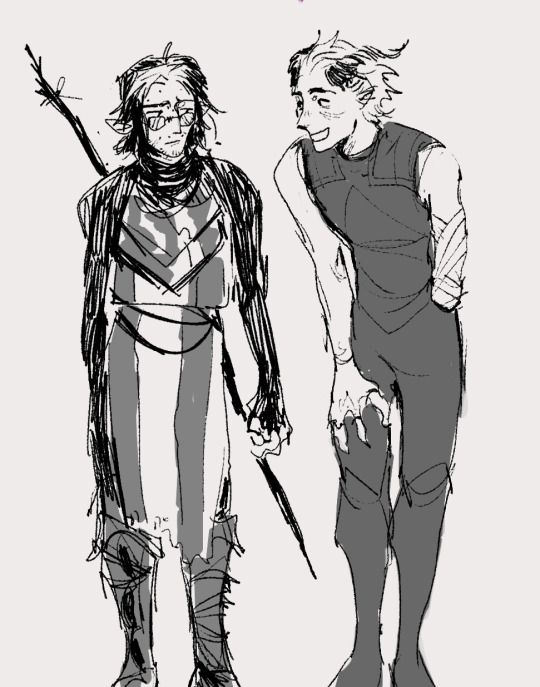

the actual reason behind our dragon age ttrpg homebrew approval system not having any debuffs for disapproval is because my guy would die. because he sucks so much
#dragon age#siofra tag#well if it isn't the yaoi brigade#wilte belongs to my dear friend @ hceinart#sorry im turning this blog into our ttrpg fanart page again. i missed them#art tag
182 notes
·
View notes
Text
the flow of having the gm move occur after the players fail or roll with fear makes a lot of narrative sense but otherwise the lack of organization in combat seems to make it a bit too easy for some players to inadvertently not do anything for ages. which i don't think is really a problem for this group of people being highly experienced ttrpg players (both in general and with each other) but i can imagine this becoming a bit more problematic with less experienced groups, as it puts the pressure on individual players to jump in and declare that they want to do something. i don't have any constructive solution to offer for this because obviously an initiative-type mechanic wouldn't be fair but just ¯\_(ツ)_/¯
#i also don't have any firsthand ttrpg experience so i am indeed a poser making comments about things i don't understand.#which i genuinely apologize for! but also this is my blog :)#1h55m OSx57#text#critical role#cr extras#daggerheart oneshot#cr lb#cr spoilers#daggerheart
69 notes
·
View notes
Text

Weathers finally getting cooler so time to break out the Halloween dice 🎃
#dice#polyhedral dice#dnd dice#Halloween#my dice#q workshop#chessex#die hard dice#and a few other brands#the eye dice were handmade#sorry for rarely posting nowadays since making this blog I got a full time job#also I play a fuck ton of ttrpgs in my free time#most of them are pathfinder first edition now lol
161 notes
·
View notes